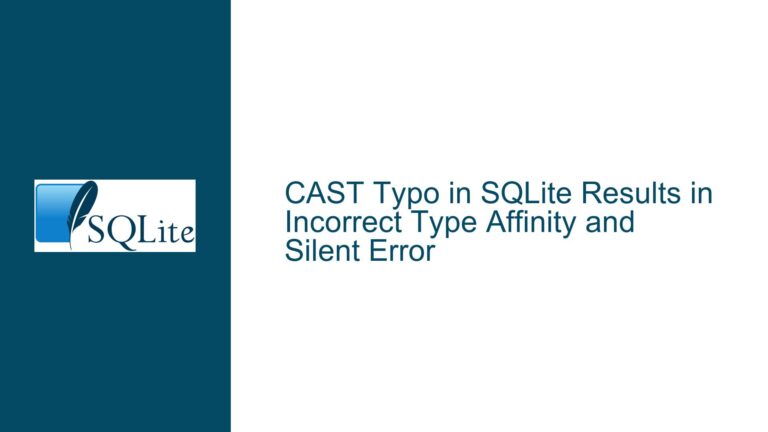Tuple Comparison Semantics in SQLite Queries
How SQLite Evaluates Row Value Comparisons Lexicographically
Fundamental Behavior of Tuple Comparisons
SQLite supports row value comparisons, a feature that allows developers to compare multiple values as cohesive units (tuples) using standard operators such as =, <, >, <>, etc. A common misunderstanding arises when interpreting how these comparisons work, particularly with inequality operators like < or >.
Consider a query comparing two tuples:
(a, b) < (x, y)
The intuitive assumption might be that this translates to a < x AND b < y, but SQLite does not use this "all elements must satisfy" logic. Instead, it evaluates tuples lexicographically, similar to dictionary ordering or version number comparisons.
Lexicographical comparison rules:
- Compare the first elements of both tuples.
- If
a < x, the entire tuple(a, b)is considered less than(x, y)regardless ofbory. - If
a > x, the tuple is considered greater.
- If
- If the first elements are equal (
a = x), compare the second elements.- If
b < y,(a, b)is less than(x, y). - If
b > y, it is greater.
- If
- This process continues for all elements in the tuple.
Example:
SELECT (2, 2, 1000) < (2, 3, 4); -- Returns 1 (TRUE)
Here, the first elements are equal (2 = 2), so the second elements are compared. Since 2 < 3, the entire left tuple is considered smaller, even though the third element (1000) is larger.
Key Takeaway:
Row value comparisons prioritize elements from left to right, stopping at the first unequal pair. This behavior mirrors how strings are compared character-by-character or how version numbers (e.g., 1.2.3 vs 1.3.0) are evaluated.
Common Misconceptions Leading to Incorrect Query Logic
Developers often misinterpret tuple comparisons due to assumptions rooted in other programming paradigms or database systems. Below are the primary causes of confusion:
Assumption of Element-Wise
ANDLogic:
A prevalent misconception is that(a, b) < (x, y)equates toa < x AND b < y. This is incorrect in SQLite. For example,(1, 4) < (2, 3)evaluates toTRUEbecause1 < 2, even though4is not less than3.Overlooking Collation Sequences:
When tuples contain text values, the comparison depends on the collation applied to the columns or expressions. For instance:SELECT ('dog', 1) < ('Dog', 2) COLLATE BINARY; -- Returns 0 (FALSE) SELECT ('dog', 1) < ('Dog', 2) COLLATE NOCASE; -- Returns 1 (TRUE)The
BINARYcollation treats ‘dog’ and ‘Dog’ as unequal (ASCII values differ), whileNOCASEmakes them equal, altering the comparison outcome.Misapplying Tuple Logic to Compound Keys:
When using tuples to filter on multi-column indexes or keys, developers might expect the comparison to leverage index scans optimally. However, lexicographical ordering might not align with the physical storage order of the index, leading to suboptimal performance if not properly understood.Equality vs. Inequality Semantics:
While(a, b) = (x, y)correctly maps toa = x AND b = y, the same does not hold for inequalities. This inconsistency trips developers who assume uniformity across operators.
Diagnosing and Resolving Tuple Comparison Issues
Step 1: Validate Comparison Logic with Controlled Examples
Start by isolating the comparison logic in a minimal test case. Use a Common Table Expression (CTE) to generate sample data and compare tuples explicitly:
WITH n(v) AS (VALUES (1), (2), (3), (4)),
t(a, b) AS (SELECT a.v, b.v FROM n a, n b)
SELECT
PRINTF('(%d,%d)', a, b) AS "(a,b)",
(a, b) < (2, 3) AS "Tuple < (2,3)",
a < 2 OR (a = 2 AND b < 3) AS "Equivalent Logic"
FROM t;
This query reveals that (a, b) < (2, 3) matches a < 2 OR (a = 2 AND b < 3), not a < 2 AND b < 3.
Step 2: Rewrite Complex Tuple Conditions Explicitly
If lexicographical behavior is unintended, decompose the tuple comparison into explicit scalar conditions. For example, to find rows where both a < 2 and b < 3:
SELECT * FROM t WHERE a < 2 AND b < 3;
Conversely, to replicate the tuple comparison’s behavior:
SELECT * FROM t WHERE a < 2 OR (a = 2 AND b < 3);
Step 3: Account for Collation in Text Comparisons
When comparing text-containing tuples, explicitly specify collations if case sensitivity or locale-specific rules matter:
SELECT ('apple', 5) < ('Banana', 3) COLLATE NOCASE; -- Case-insensitive comparison
Step 4: Optimize Index Usage for Tuple Comparisons
To ensure efficient index utilization when filtering on multi-column tuples, structure indexes to match the comparison order. For (a, b) < (x, y), an index on (a, b) will be effective because the lexicographical comparison aligns with the index’s storage order.
Step 5: Use Row Values for Range Queries
Leverage tuple comparisons to simplify range queries. For example, to find rows where (a, b) is between (1, 5) and (3, 2):
SELECT * FROM t
WHERE (a, b) > (1, 5)
AND (a, b) < (3, 2);
This is equivalent to:
SELECT * FROM t
WHERE (a > 1 OR (a = 1 AND b > 5))
AND (a < 3 OR (a = 3 AND b < 2));
Step 6: Debugging with Intermediate Results
When troubleshooting queries, materialize intermediate results to inspect how tuples are ordered:
CREATE TEMP TABLE debug AS
SELECT a, b, (a, b) AS tuple FROM t;
SELECT * FROM debug ORDER BY tuple;
This reveals the actual sorting order applied by SQLite, helping identify mismatches between expected and actual results.
Step 7: Edge Case Handling
- NULL Values: Comparisons involving
NULLfollow SQL’s three-valued logic. For example,(NULL, 5) < (2, 3)evaluates toNULL, notTRUEorFALSE. UseIS NULLorIS NOT NULLto handle such cases. - Mismatched Lengths: Comparing tuples of different lengths (e.g.,
(a, b)vs(x, y, z)) raises an error. Ensure uniformity in tuple dimensions.
Final Recommendation:
Always refer to SQLite’s Row Value documentation and validate assumptions with empirical tests. Explicitly document tuple comparison logic in code to prevent misunderstandings among team members.
This guide equips developers to harness SQLite’s row value comparisons effectively while avoiding common pitfalls through rigorous testing and explicit condition rewriting.






